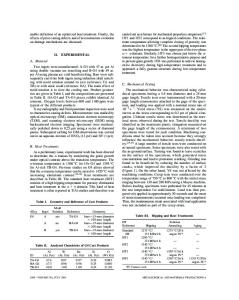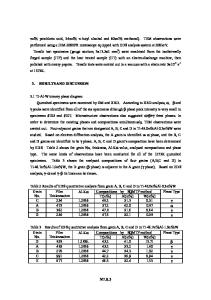Strain-Rate Effects on the room Temperature Tensile Properties of a TiAl Alloy
- PDF / 5,313,609 Bytes
- 7 Pages / 420.48 x 639 pts Page_size
- 32 Downloads / 369 Views
STRAIN-RATE EFFECTS ON THE ROOM TEMPERATURE TENSILE PROPERTIES OF A TiAI ALLOY Y-W. Kim* and D.M. Dimiduk**, *UES, Materials Research Division, 4401 Dayton-Xenia Rd., Dayton, OH 45432 "**Wright-Laboratory, WL/MLLM, WPAFB, OH 45433 ABSTRACT The room temperature tensile properties and fracture behavior of a Ti-47AI1.5Cr-IV-2.3Nb gamma TiAl alloy, have been investigated for two duplex and a fullylamellar microstructural conditions. These microstructures were controlled through forging and subsequent recrystallization/solution treatments followed by furnace cooling and aging treatment at 9000C. Tensile testing was conducted on either asmachined or electropolished round-bar specimens over a range of strain rates from 10-5 to 10-1 sec- 1 in laboratory air. Experiments showed that both tensile ductility and strength levels vary not only with microstructure and surface condition, but also with applied strain rate in an unexpected way. The complex relationships between these variables are under continuing investigation. The results to date, which were analyzed using microstructural observations made on the deformed and fractured specimens, indicate that the deformation and fracture modes remain essentially the same within the strain rate range used. The possible involvement of environmental effects in the fracture process is suggested. INTRODUCTION Gamma titanium-aluminide alloys of engineering importance consist of Llo gamma TiAl as a matrix phase and small amounts of DOi9 Ti3AI. Collectively, prior studies show, at least qualitatively, that the mechanical properties of gamma alloys are controlled by the distribution of these phases including morphologies, relative amounts, and sizes [1,2]. Depending upon the distribution and morphology of the phases, the microstructures can be classified into two types-standard and engineered [1-4]. Duplex and fully-lamellar(FL) microstructures are two typical standard types and have been characterized quite extensively for mechanical properties [2,5,6]. From these studies, some characteristic deficiencies were found [2,7], including the inverse relationship between ductility and toughness, in that duplex microstructures exhibit reasonable ductility but poor toughness while the opposite is true for FL structures. The engineered microstructures, which are essentially modified lamellar structures, have been developed to improve upon these deficiencies with some success [3,4], but their optimization is far from being complete. Clearly, the effects of micro structure on the mechanical properties, especially RT tensile properties, are far greater than we have known and expected. In connection with the microstructural effects, other factors such as strain rate, specimen surface conditions and test environment, appear to significantly influence tensile properties. Growing evidence indicates that tensile testing in laboratory air reduces the RT ductility of gamma TiAl in the duplex[8] and single-phase gamma[91 microstructure conditions, as well as in unidirectional FL PST crystals[10]. This paper
Data Loading...











